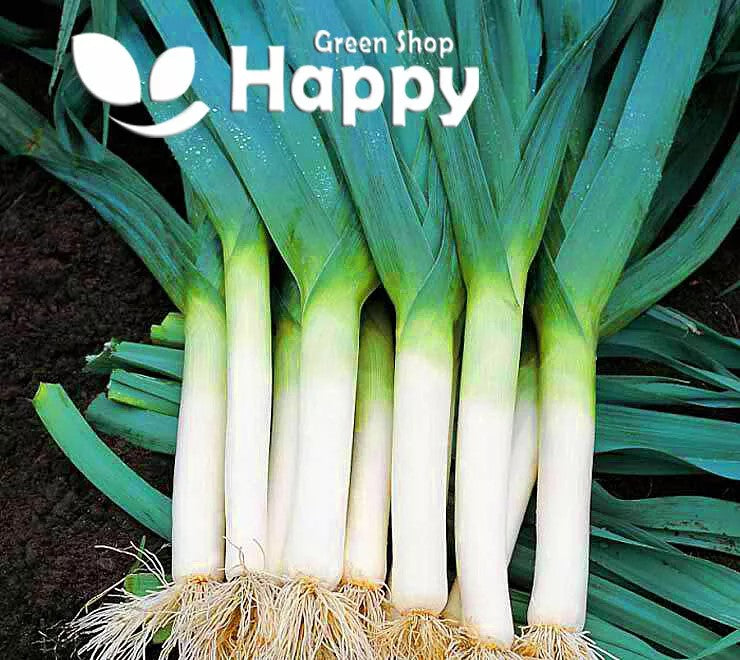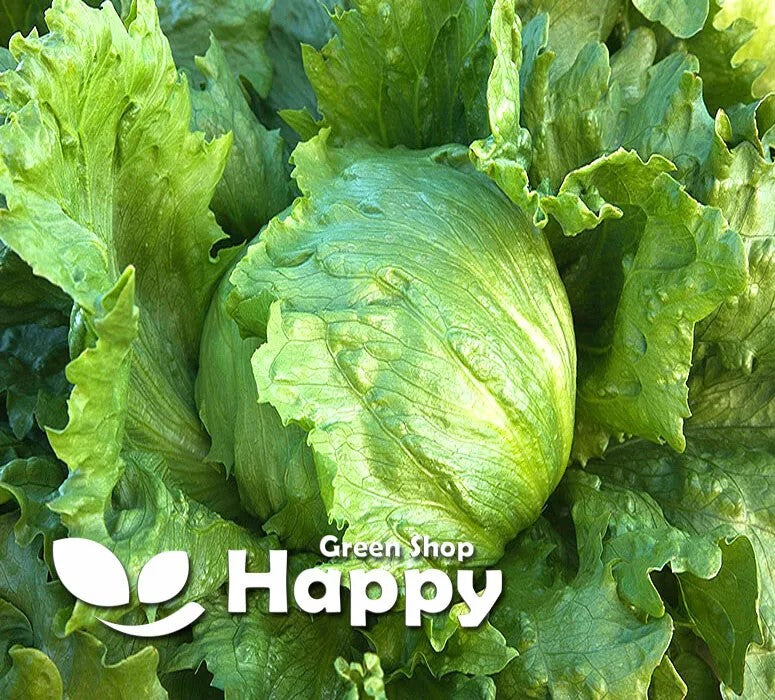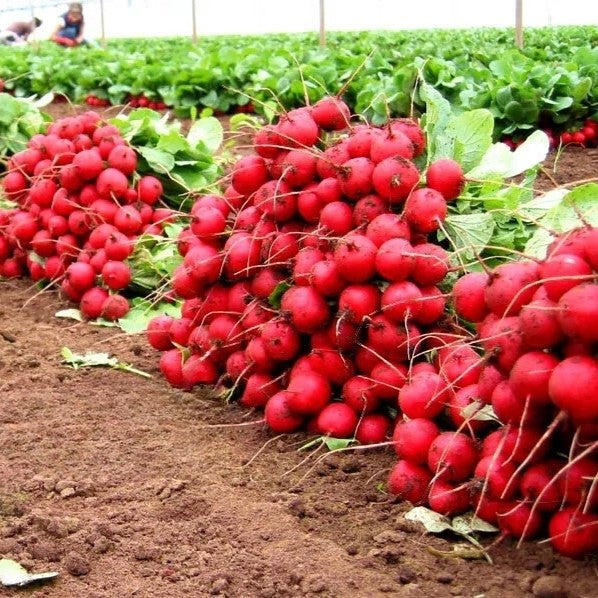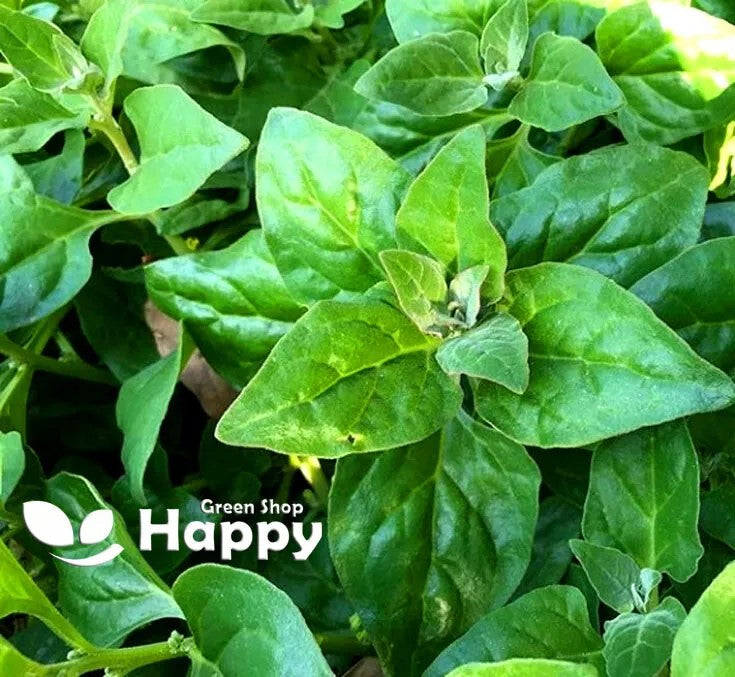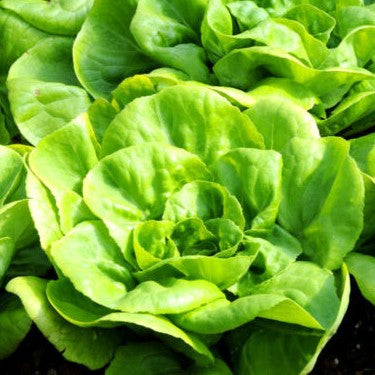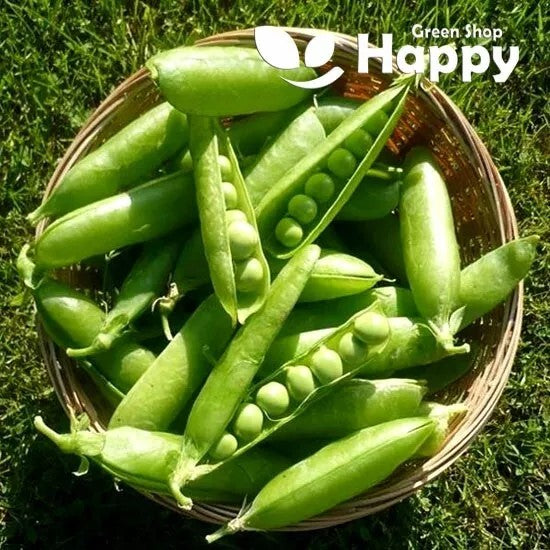Sort by:
299 products
299 products
Iceberg Lettuce ‘Great Lakes 118’ Seeds (Lactuca sativa)
Grow crisp, refreshing heads with Iceberg Lettuce ‘Great Lakes 118’ (Lactuca sativa). This classic variety produces firm, compact, light-green heads with a crunchy texture, perfect for fresh salads, sandwiches, and burgers. Easy to grow and early-maturing, it’s ideal for vegetable gardens, raised beds, and continuous harvests.
How to Grow
-
Sow seeds directly outdoors from early spring to early summer, or indoors for transplanting.
-
Use fertile, well-drained soil in full sun to partial shade.
-
Sow seeds thinly and cover lightly with soil; keep moist until germination (7–14 days).
-
Thin seedlings to 25–30 cm apart for healthy head development.
-
Harvest heads when firm and fully formed, before they bolt.
Key Features
-
Firm, compact, light-green heads with crunchy texture
-
Early-maturing and easy to grow
-
Ideal for fresh salads, sandwiches, and burgers
-
Reliable and productive in temperate climates
-
Suitable for outdoor or protected cultivation
Ideal For
-
Vegetable gardens, raised beds, and allotments
-
Fresh salads, sandwiches, and burgers
-
Continuous harvest with succession sowing
-
Homegrown kitchen gardens
Sowing
-
Best time: Early spring to early summer outdoors or indoors for transplanting
-
Germination: 7–14 days
-
Spacing: Thin to 25–30 cm apart
-
Prefers full sun to partial shade and fertile, well-drained soil
Quick Tip
-
Sow in successive batches every 2–3 weeks to enjoy a continuous supply of crisp heads.
Red Carrot ‘Korina’ Seeds (Daucus carota)
Add vibrant color to your garden with Red Carrot ‘Korina’ (Daucus carota). This early-maturing variety produces bright red, tapered roots with sweet, crisp flesh, perfect for salads, cooking, and roasting. Easy to grow and highly productive, it’s ideal for vegetable gardens, raised beds, and succession sowing.
How to Grow
-
Sow seeds directly outdoors from early spring to midsummer.
-
Use fertile, well-drained soil in full sun.
-
Sow seeds 1 cm deep and thin seedlings to 5–8 cm apart.
-
Keep soil consistently moist to support germination (10–14 days).
-
Harvest roots when they reach full size but remain tender for best flavor.
Key Features
-
Bright red, sweet, and crisp tapered roots
-
Early-maturing and easy to grow
-
Ideal for salads, cooking, and roasting
-
Reliable and productive in temperate climates
-
Suitable for succession sowing for continuous harvest
Ideal For
-
Vegetable gardens, raised beds, and kitchen gardens
-
Fresh salads, cooking, and roasting
-
Succession sowing for continuous harvest
-
Homegrown culinary use
Sowing
-
Best time: Early spring to midsummer outdoors
-
Depth: 1 cm
-
Spacing: Thin to 5–8 cm apart
-
Prefers full sun and fertile, well-drained soil
Quick Tip
-
Sow in successive batches every 2–3 weeks to enjoy a steady supply of vibrant, sweet roots.
Chantenay Carrot ‘Charisma’ F1 Seeds (Daucus carota)
Grow high-yield, flavorful carrots with Chantenay Carrot ‘Charisma’ F1 (Daucus carota). This uniform, early-maturing variety produces thick, short, orange roots with excellent taste, ideal for fresh salads, cooking, and roasting. Hardy and easy to grow, it’s perfect for kitchen gardens, raised beds, and succession sowing.
How to Grow
-
Sow seeds directly outdoors from early spring to midsummer.
-
Use fertile, well-drained soil in full sun.
-
Sow seeds 1 cm deep and thin seedlings to 5–8 cm apart.
-
Keep soil consistently moist for optimal germination (10–14 days).
-
Harvest roots when fully grown but still tender for best flavor.
Key Features
-
Thick, short, uniform orange roots
-
Early-maturing, high-yield F1 hybrid
-
Sweet and flavorful, perfect for salads, cooking, or roasting
-
Reliable and easy to grow
-
Suitable for succession sowing and continuous harvest
Ideal For
-
Vegetable gardens, raised beds, and allotments
-
Fresh salads, cooking, and roasting
-
Succession sowing for steady harvests
-
Homegrown culinary use
Sowing
-
Best time: Early spring to midsummer outdoors
-
Depth: 1 cm
-
Spacing: Thin to 5–8 cm apart
-
Prefers full sun and fertile, well-drained soil
Quick Tip
-
Sow in successive batches every 2–3 weeks to enjoy a continuous supply of tender, sweet roots.
Carrot ‘Olympus’ Flakke Type Seeds (Daucus carota)
Grow sweet, crunchy carrots with Carrot ‘Olympus’ Flakke Type (Daucus carota). This early-maturing variety produces flat, broad, orange roots with excellent flavor, perfect for salads, cooking, and roasting. Easy to grow and reliable, it’s ideal for vegetable gardens, raised beds, and succession sowing.
How to Grow
-
Sow seeds directly outdoors from early spring to midsummer.
-
Use fertile, well-drained soil in full sun.
-
Sow seeds 1 cm deep and thin seedlings to 5–8 cm apart.
-
Keep soil consistently moist to support germination (10–14 days).
-
Harvest roots when they reach full size but remain tender.
Key Features
-
Flat, broad, sweet, and crunchy orange roots
-
Early-maturing and easy to grow
-
Ideal for salads, cooking, and roasting
-
Reliable and productive in temperate climates
-
Suitable for succession sowing for continuous harvest
Ideal For
-
Vegetable gardens and raised beds
-
Fresh salads, cooking, and roasting
-
Succession sowing for steady harvests
-
Kitchen gardens and allotments
Sowing
-
Best time: Early spring to midsummer outdoors
-
Depth: 1 cm
-
Spacing: Thin to 5–8 cm apart
-
Prefers full sun and fertile, well-drained soil
Quick Tip
-
Sow in successive batches every 2–3 weeks for a continuous supply of tender, sweet roots.
Radish ‘Carmen’ Seeds (Raphanus sativus)
Add crisp, vibrant color to your garden with Radish ‘Carmen’ (Raphanus sativus). This fast-growing variety produces round, bright red roots with a mild, crunchy flavor, perfect for fresh salads, garnishes, and quick harvests. Easy to grow and reliable, it’s ideal for both kitchen gardens and raised beds.
How to Grow
-
Sow seeds directly outdoors from early spring to late summer.
-
Use well-drained, fertile soil in full sun.
-
Sow seeds 1–2 cm deep and thin seedlings to 5–8 cm apart.
-
Keep soil consistently moist for best germination and growth (5–10 days).
-
Harvest roots when fully formed but tender for best flavor.
Key Features
-
Round, bright red roots with mild, crunchy flavor
-
Fast-growing and easy to cultivate
-
Ideal for fresh salads, garnishes, and snacking
-
Reliable and productive in temperate climates
-
Suitable for successive sowing for continuous harvest
Ideal For
-
Kitchen gardens and raised beds
-
Fresh salads, garnishes, and cooking
-
Succession sowing for continuous harvest
-
Adding vibrant color to vegetable beds
Sowing
-
Best time: Early spring to late summer outdoors
-
Depth: 1–2 cm
-
Spacing: Thin to 5–8 cm apart
-
Prefers full sun and fertile, well-drained soil
Quick Tip
-
Sow every 2–3 weeks for a steady supply of tender, colorful radishes throughout the season.
Radish ‘Gigante Siculo’ Seeds (Raphanus sativus)
Grow impressive, crisp radishes with Radish ‘Gigante Siculo’ (Raphanus sativus). This unique variety produces large, elongated roots with mild, sweet flavor, perfect for salads, roasting, or pickling. Easy to grow and fast-maturing, it provides a striking addition to vegetable gardens and kitchen beds.
How to Grow
-
Sow seeds directly outdoors from early spring to late summer.
-
Use well-drained, fertile soil in full sun.
-
Sow seeds 1–2 cm deep and thin seedlings to 10–15 cm apart.
-
Keep soil consistently moist for best growth.
-
Harvest roots when they reach full size but remain tender.
Key Features
-
Large, elongated roots with mild, sweet flavor
-
Fast-maturing and easy to grow
-
Ideal for salads, roasting, or pickling
-
Adds visual interest to vegetable gardens
-
Hardy and productive variety
Ideal For
-
Vegetable gardens and kitchen beds
-
Fresh salads, cooking, and pickling
-
Companion planting with leafy greens
-
Showcasing unique, large radishes in garden displays
Sowing
-
Best time: Early spring to late summer outdoors
-
Depth: 1–2 cm
-
Spacing: Thin to 10–15 cm apart
-
Prefers full sun and fertile, well-drained soil
Quick Tip
-
Sow in successive batches for a continuous supply of large, crisp roots.
New Zealand Spinach Seeds (Tetragonia tetragonioides)
Grow a heat-tolerant alternative to traditional spinach with New Zealand Spinach (Tetragonia tetragonioides). This hardy, fast-growing leafy green produces succulent, nutrient-rich leaves ideal for salads, steaming, or sautéing. Perfect for summer gardens, it thrives in warm weather when regular spinach struggles, providing a continuous harvest of fresh greens.
How to Grow
-
Sow seeds directly outdoors after the last frost when soil has warmed.
-
Use well-drained, fertile soil in full sun to partial shade.
-
Sow seeds 1–2 cm deep and thin seedlings to 25–30 cm apart.
-
Keep soil consistently moist for best growth.
-
Harvest young leaves regularly or cut mature leaves, leaving the plant to regrow.
Key Features
-
Heat-tolerant alternative to traditional spinach
-
Fast-growing, nutrient-rich leaves
-
Hardy and easy to grow
-
Ideal for salads, steaming, or sautéing
-
Provides continuous harvest throughout warm seasons
Ideal For
-
Vegetable gardens and raised beds
-
Summer harvesting when regular spinach struggles
-
Fresh salads, cooking, and sautéed greens
-
Continuous harvest of nutrient-rich leaves
Sowing
-
Best time: After last frost, when soil is warm
-
Depth: 1–2 cm
-
Spacing: Thin to 25–30 cm apart
-
Prefers full sun to partial shade and fertile, well-drained soil
Quick Tip
-
Regularly harvest outer leaves to encourage continuous growth throughout the season.
Butterhead Lettuce ‘All Year Round’ Seeds (Lactuca sativa)
Enjoy fresh, tender salad leaves throughout the season with Butterhead Lettuce ‘All Year Round’ (Lactuca sativa). This versatile variety produces soft, buttery-textured leaves with a mild flavor, perfect for salads, sandwiches, and garnishes. Easy to grow and quick to mature, it thrives in both outdoor and greenhouse conditions.
How to Grow
-
Sow seeds directly outdoors from early spring to late summer or indoors for transplanting.
-
Use fertile, well-drained soil in full sun to partial shade.
-
Sow seeds thinly, cover lightly with soil, and keep moist until germination (7–14 days).
-
Thin seedlings to 20–25 cm apart for healthy growth.
-
Harvest outer leaves regularly or cut the whole head when mature.
Key Features
-
Tender, buttery-textured leaves with mild flavor
-
Quick-growing and versatile variety
-
Suitable for outdoor and greenhouse cultivation
-
Ideal for continuous harvest throughout the season
-
Easy to grow and maintain
Ideal For
-
Fresh salads, sandwiches, and garnishes
-
Kitchen gardens and raised beds
-
Continuous harvest in outdoor or protected environments
-
Pollinator-friendly garden spaces
Sowing
-
Best time: Early spring to late summer outdoors or indoors for transplanting
-
Germination: 7–14 days
-
Sow thinly, cover lightly, keep soil moist
-
Prefers full sun to partial shade and fertile, well-drained soil
Quick Tip
-
Sow in successive batches every 2–3 weeks for a continuous supply of tender leaves.
Pea ‘Rondo’ Maincrop Seeds (Pisum sativum)
Enjoy a bountiful late-season harvest with Pea ‘Rondo’ Maincrop (Pisum sativum). This hardy climbing variety produces long, plump pods packed with sweet, tender peas, perfect for fresh eating, steaming, or freezing. Reliable and highly productive, it’s ideal for vegetable gardens, allotments, and extended homegrown harvests.
How to Grow
-
Sow seeds directly outdoors from early spring to late spring.
-
Use well-drained, fertile soil in full sun to partial shade.
-
Sow seeds 3–5 cm deep and 5–7 cm apart in rows 50–60 cm apart.
-
Provide stakes, netting, or a trellis for climbing growth.
-
Keep soil consistently moist but avoid waterlogging.
-
Harvest pods when fully formed but still tender for best flavor.
Key Features
-
Maincrop variety producing long, plump, sweet pods
-
Hardy, climbing, and highly productive
-
Ideal for fresh eating, steaming, or freezing
-
Reliable in temperate climates
-
Perfect for vegetable gardens and allotments
Ideal For
-
Vegetable gardens and allotments
-
Extended harvest for cooking and freezing
-
Climbing support with trellises or stakes
-
Companion planting with nitrogen-fixing crops
Sowing
-
Best time: Early to late spring outdoors
-
Depth: 3–5 cm
-
Spacing: 5–7 cm apart, rows 50–60 cm apart
-
Prefers full sun to partial shade and fertile, well-drained soil
Quick Tip
-
Sow in successive batches every 2–3 weeks for a longer maincrop harvest.
Showing 180/299


